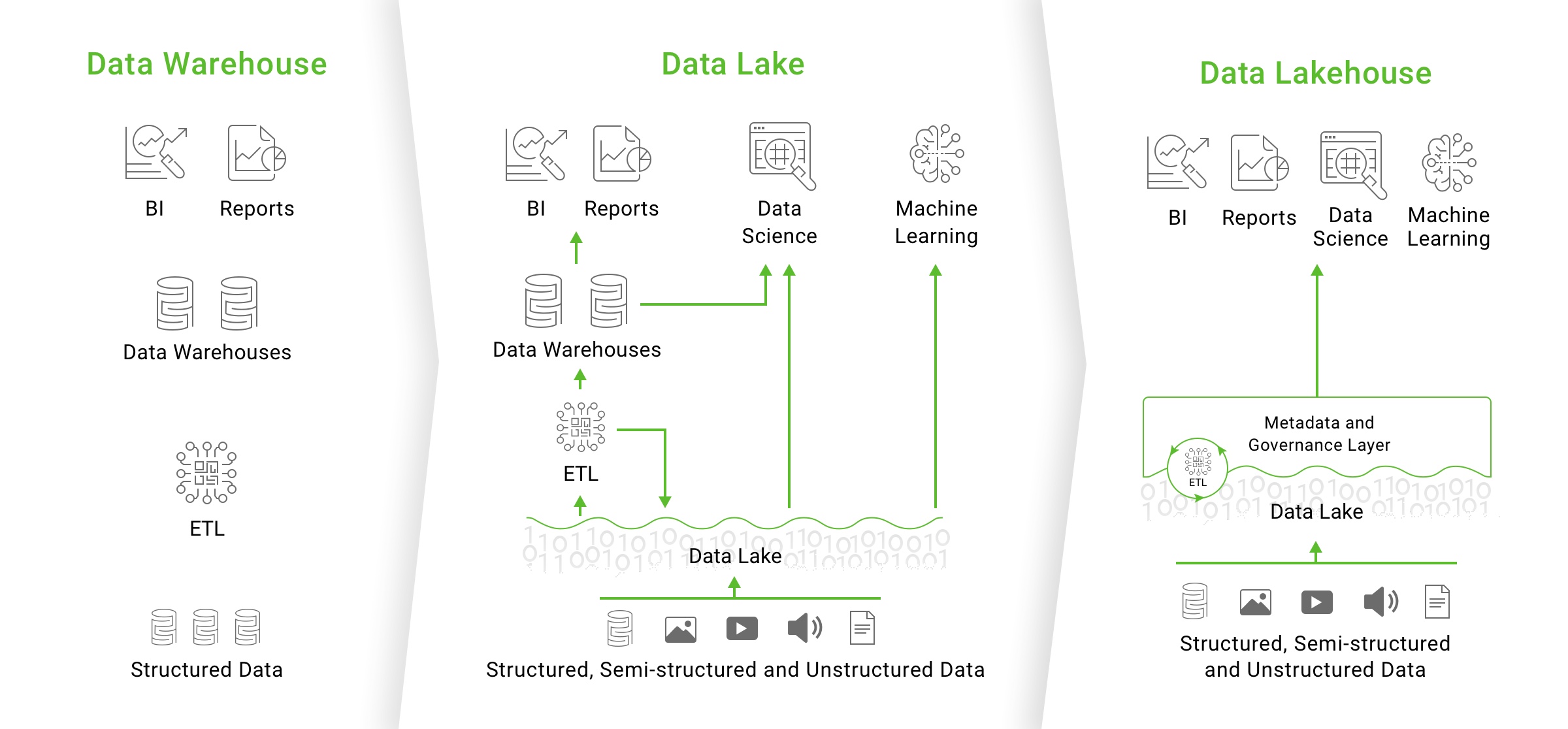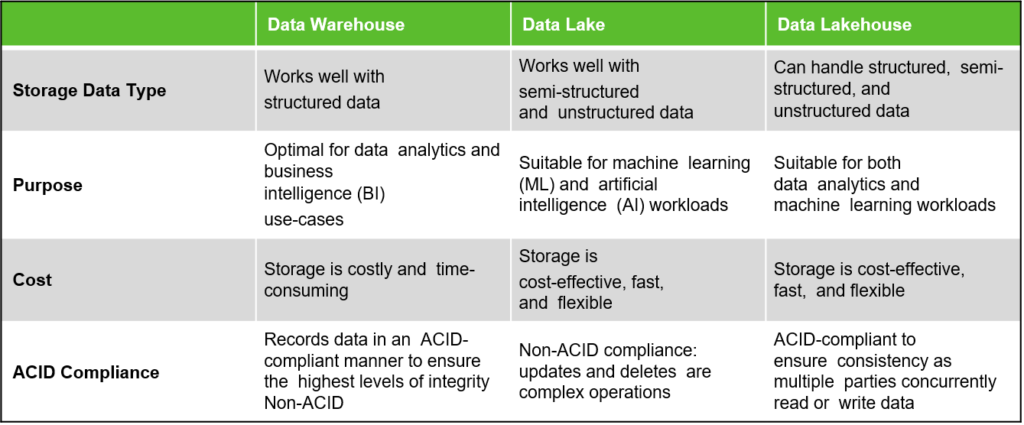In recent years, we have witnessed the emergence of a new data management architecture that evolved independently across numerous clients and use cases- data lakehouse. In this blog, we depict this novel data management architecture and its benefits over the traditional methods.
Business intelligence applications have traditionally used data warehouses an information storage architecture ideal for structured data. Data warehouse technology has evolved since its introduction in the late 1980s and MPP architectures have led to systems that can manage larger volumes of data. With the dawn of the Big Data era, businesses began to unlock the value of working with unstructured data, semi-structured data, and data with high variety, velocity, and volume. Unfortunately, a number of these use cases didn’t fit well with the data warehouse model and its structured and ordered way of information storage.
With businesses gathering more and more data from a variety of sources, architects began to imagine a single system that could contain data for a variety of analytic products and workloads. A decade ago, companies started establishing data lakes, where unstructured information is stored in its raw format. While data lakes are hugely powerful and flexible architectures enabling enterprises to capture all their data in every format and not just relational data, they lack some key features: they don’t support transactions; they don’t enforce data quality; and their lack of consistency makes it nearly impossible to mix appends and reads, and batch and streaming jobs. Furthermore, there is a lack of robust governance and privacy protection, and the data layout might not be organized for performance. As a result of these limitations, many of the promises of data lakes have not materialized.
The need for a flexible, high-performance system is constantly increasing, as many recent AI advancements have been better models to process unstructured data (text, photos, video, and audio). However, these are the types of data that a data warehouse is not designed to handle. The typical solution is to use several systems, such as a data lake, multiple data warehouses, and other specialized systems like streaming, time-series, graph, and picture databases. But having a variety of systems adds complexity and, more crucially, delay, because data professionals must frequently move or copy data across systems. To overcome these problems, enterprises working with large and varied data sets have developed a new approach: a hybrid architecture called the data lakehouse.

Enterprise software company, Databricks uses the portmanteau “lakehouse” in their paper (Lakehouse: A New Generation of Open Platforms that Unify Data Warehousing and Advanced Analytics), which argues that the data warehouse architecture will wither in the coming years and be replaced by a new architecture called the lakehouse. Instead of the two-tier data lake + relational data warehouse model, you will just need a data lakehouse, which is made possible by implementing data warehousing functionality over open data lake file formats.
A data lakehouse, as the name proposes, is a unified platform for data storage new, open data architecture that merges a data warehouse and data lake into a single whole, with the purpose of addressing each one’s limitations. In brief, the lakehouse system uses low-cost storage to keep enormous volumes of information in raw formats very much like data lakes. ‘At the same time, it brings structure to data and empowers data management features like data warehouses by implementing the metadata layer on top of the store. This allows various teams to utilize a single system to get all the enterprise data for a scope of projects, including data science, machine learning, and business insights. Unlike data warehouses, the lakehouse architecture can store and process loads of varied data at a lower cost, and unlike data lakes, that information can be managed and optimized for SQL performance.
A lakehouse is a new, open architecture that combines the best elements of data lakes and data warehouses. Lakeshouses are enabled by a new open and standardized system design: implementing similar data structures and data management features to those in a data warehouse, directly on the kind of low cost storage used for data lakes
key features of lakehouse:
As a combination of the components of data warehouses and data lakes, data lake house feature elements of both data platforms. The key features of data lakehouse are:
Data warehouses aren’t optimized for unstructured information types making it necessary to concurrently manage multiple systems: a data lake, numerous data warehouses, and different specialized structures. Maintaining numerous structures is a costly affair and can even impair your capacity to access timely data insights.
A single data lakehouse has numerous advantages over a multiple-solution system, including:
In Spite of all the buzz around lakehouse, it’s worth remembering that the concept is still nascent. Below are some drawbacks to be considered before committing to data lakehouse architecture:


In the future, the data warehouse architecture we know today is likely to be replaced by the innovative lakehouse approach, which will offer open direct-access data formats, support for machine learning and data science, superior performance, and lower costs.
But despite the benefits, enterprise organizations are not expected to immediately embrace lakehouse architecture and abandon their investments in Amazon Redshift, Google BigQuery, Microsoft Azure, Data Lake or Snowflake.
Still, the lakehouse ecosystem is growing and many vendors seem to be heading in that direction. The Databricks Lakehouse Platform, and Microsoft’s Azure Synapse Analytics service, (which integrates with Azure Databricks) already use the lakehouse approach. Other services such as BigQuery and Redshift Spectrum have some of the lakehouse features listed above, though they are models that focus primarily on BI and other SQL applications. Companies who want to construct their own lakehouse storage systems have access to open source file formats (Delta Lake, Apache Iceberg, Apache Hudi) that are suitable for the purpose.
Hopefully, after reading this blog post, you have a better understanding of how data lakehouse architecture is changing the way we store and manage Big Data, unlocking new capabilities and improved efficiencies that will increase performance and reduce cost. Put it all together and one thing becomes clear: lakehouse is here to stay!
Explore More
Cloud 3 Min Read
Data Analytics 6 Min Read




Experience the power of our cutting-edge technology firsthand
© 2025 TRINGAPPS, INC. ALL RIGHTS RESERVED